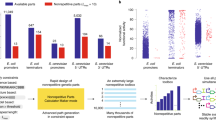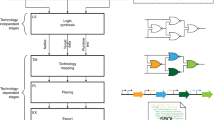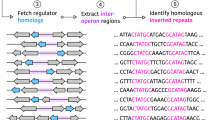Abstract
Genetic circuits perform computational operations based on interactions between freely diffusing molecules within a cell. When transcription factors are combined to build a circuit, unintended interactions can disrupt its function. Here, we apply 'part mining' to build a library of 73 TetR-family repressors gleaned from prokaryotic genomes. The operators of a subset were determined using an in vitro method, and this information was used to build synthetic promoters. The promoters and repressors were screened for cross-reactions. Of these, 16 were identified that both strongly repress their cognate promoter (5- to 207-fold) and exhibit minimal interactions with other promoters. Each repressor-promoter pair was converted to a NOT gate and characterized. Used as a set of 16 NOT/NOR gates, there are >1054 circuits that could be built by changing the pattern of input and output promoters. This represents a large set of compatible gates that can be used to construct user-defined circuits.
This is a preview of subscription content, access via your institution
Access options
Subscribe to this journal
Receive 12 print issues and online access
$259.00 per year
only $21.58 per issue
Buy this article
- Purchase on Springer Link
- Instant access to full article PDF
Prices may be subject to local taxes which are calculated during checkout





Similar content being viewed by others
References
Weiss, R. & Knight, T. Jr DNA Computing Vol. 2054 (eds. Condon, A. & Rozenberg, G.) 1–16 (2001).
Khalil, A.S. & Collins, J.J. Synthetic biology: applications come of age. Nat. Rev. Genet. 11, 367–379 (2010).
Weber, W. & Fussenegger, M. Molecular diversity—the toolbox for synthetic gene switches and networks. Curr. Opin. Chem. Biol. 15, 414–420 (2011).
Endy, D. Foundations for engineering biology. Nature 438, 449–453 (2005).
Purnick, P.E. & Weiss, R. The second wave of synthetic biology: from modules to systems. Nat. Rev. Mol. Cell Biol. 10, 410–422 (2009).
Moser, F. et al. Genetic circuit performance under conditions relevant for industrial bioreactors. ACS Synth. Biol. 1, 555–564 (2012).
Thompson, K.E., Bashor, C.J., Lim, W.A. & Keating, A.E. SYNZIP protein interaction toolbox: in vitro and in vivo specifications of heterospecific coiled-coil interaction domains. ACS Synth. Biol. 1, 118–129 (2012).
Yokobayashi, Y., Weiss, R. & Arnold, F.H. Directed evolution of a genetic circuit. Proc. Natl. Acad. Sci. USA 99, 16587–16591 (2002).
Tabor, J.J., Levskaya, A. & Voigt, C.A. Multichromatic control of gene expression in Escherichia coli. J. Mol. Biol. 405, 315–324 (2011).
Fu, G. et al. Female-specific flightless phenotype for mosquito control. Proc. Natl. Acad. Sci. USA 107, 4550–4554 (2010).
Tamsir, A., Tabor, J.J. & Voigt, C.A. Robust multicellular computing using genetically encoded NOR gates and chemical 'wires'. Nature 469, 212–215 (2011).
Gardner, T.S., Cantor, C.R. & Collins, J.J. Construction of a genetic toggle switch in Escherichia coli. Nature 403, 339–342 (2000).
Elowitz, M.B. & Leibler, S. A synthetic oscillatory network of transcriptional regulators. Nature 403, 335–338 (2000).
Hurt, J.A., Thibodeau, S.A., Hirsh, A.S., Pabo, C.O. & Joung, J.K. Highly specific zinc finger proteins obtained by directed domain shuffling and cell-based selection. Proc. Natl. Acad. Sci. USA 100, 12271–12276 (2003).
Boch, J. et al. Breaking the code of DNA binding specificity of TAL-type III effectors. Science 326, 1509–1512 (2009).
Khalil, A.S. et al. A synthetic biology framework for programming eukaryotic transcription functions. Cell 150, 647–658 (2012).
Garg, A., Lohmueller, J.J., Silver, P.A. & Armel, T.Z. Engineering synthetic TAL effectors with orthogonal target sites. Nucleic Acids Res. 40, 7584–7595 (2012).
Zhang, F. et al. Efficient construction of sequence-specific TAL effectors for modulating mammalian transcription. Nat. Biotechnol. 29, 149–153 (2011).
Politz, M.C., Copeland, M.F. & Pfleger, B.F. Artificial repressors for controlling gene expression in bacteria. Chem. Commun. (Camb.) 49, 4325–4327 (2013).
Durai, S., Bosley, A., Abulencia, A.B., Chandrasegaran, S. & Ostermeier, M. A bacterial one-hybrid selection system for interrogating zinc finger–DNA interactions. Comb. Chem. High Throughput Screen. 9, 301–311 (2006).
Qi, L.S. et al. Repurposing CRISPR as an RNA-guided platform for sequence-specific control of gene expression. Cell 152, 1173–1183 (2013).
Ramos, J.L. et al. The TetR family of transcriptional repressors. Microbiol. Mol. Biol. Rev. 69, 326–356 (2005).
Lutz, R. & Bujard, H. Independent and tight regulation of transcriptional units in Escherichia coli via the LacR/O, the TetR/O and AraC/I1–I2 regulatory elements. Nucleic Acids Res. 25, 1203–1210 (1997).
Guss, A.M., Rother, M., Zhang, J.K., Kulkarni, G. & Metcalf, W.W. New methods for tightly regulated gene expression and highly efficient chromosomal integration of cloned genes for Methanosarcina species. Archaea 2, 193–203 (2008).
Dingermann, T. et al. RNA polymerase III catalysed transcription can be regulated in Saccharomyces cerevisiae by the bacterial tetracycline repressor-operator system. EMBO J. 11, 1487–1492 (1992).
Lycett, G.J., Kafatos, F.C. & Loukeris, T.G. Conditional expression in the malaria mosquito Anopheles stephensi with Tet-On and Tet-Off systems. Genetics 167, 1781–1790 (2004).
Gatz, C. & Quail, P.H. Tn10-encoded tet repressor can regulate an operator-containing plant promoter. Proc. Natl. Acad. Sci. USA 85, 1394–1397 (1988).
Gossen, M. & Bujard, H. Tight control of gene expression in mammalian cells by tetracycline-responsive promoters. Proc. Natl. Acad. Sci. USA 89, 5547–5551 (1992).
Saez, E., No, D., West, A. & Evans, R.M. Inducible gene expression in mammalian cells and transgenic mice. Curr. Opin. Biotechnol. 8, 608–616 (1997).
Weber, W. et al. A synthetic time-delay circuit in mammalian cells and mice. Proc. Natl. Acad. Sci. USA 104, 2643–2648 (2007).
Orth, P., Schnappinger, D., Hillen, W., Saenger, W. & Hinrichs, W. Structural basis of gene regulation by the tetracycline inducible Tet repressor-operator system. Nat. Struct. Biol. 7, 215–219 (2000).
Helbl, V., Tiebel, B. & Hillen, W. Stepwise selection of TetR variants recognizing tet operator 6C with high affinity and specificity. J. Mol. Biol. 276, 319–324 (1998).
Krueger, M., Scholz, O., Wisshak, S. & Hillen, W. Engineered Tet repressors with recognition specificity for the tetO-4C5G operator variant. Gene 404, 93–100 (2007).
Itzkovitz, S., Tlusty, T. & Alon, U. Coding limits on the number of transcription factors. BMC Genomics 7, 239 (2006).
Hunter, S. et al. InterPro in 2011: new developments in the family and domain prediction database. Nucleic Acids Res. 40, D306–D312 (2012).
Warren, C.L. et al. Defining the sequence-recognition profile of DNA-binding molecules. Proc. Natl. Acad. Sci. USA 103, 867–872 (2006).
Stanton, B.C. et al. Cognate Site Identifier analysis reveals novel binding properties of the Sex Inducer homeodomain proteins of Cryptococcus neoformans. Mol. Microbiol. 72, 1334–1347 (2009).
Bailey, T.L., Williams, N., Misleh, C. & Li, W.W. MEME: discovering and analyzing DNA and protein sequence motifs. Nucleic Acids Res. 34, W369–W373 (2006).
Kelly, J.R. et al. Measuring the activity of BioBrick promoters using an in vivo reference standard. J. Biol. Eng. 3, 4 (2009).
Grkovic, S., Brown, M.H., Schumacher, M.A., Brennan, R.G. & Skurray, R.A. The staphylococcal QacR multidrug regulator binds a correctly spaced operator as a pair of dimers. J. Bacteriol. 183, 7102–7109 (2001).
Kittleson, J.T., Wu, G.C. & Anderson, J.C. Successes and failures in modular genetic engineering. Curr. Opin. Chem. Biol. 16, 329–336 (2012).
Rudell, R.L. Mutiple-valued Logic Minimization for PLA Synthesis (Electronics Research Laboratory, College of Engineering, University of California, 1986).
Brown, S.V.Z. Fundamentals of Digital Logic with Verilog Design 2nd edn. (McGraw-Hill, 2008).
Lou, C., Stanton, B., Chen, Y.J., Munsky, B. & Voigt, C.A. Ribozyme-based insulator parts buffer synthetic circuits from genetic context. Nat. Biotechnol. 30, 1137–1142 (2012).
Daniel, R., Rubens, J.R., Sarpeshkar, R. & Lu, T.K. Synthetic analog computation in living cells. Nature 497, 619–623 (2013).
Chen, Y.J. et al. Characterization of 582 natural and synthetic terminators and quantification of their design constraints. Nat. Methods 10, 659–664 (2013).
Sleight, S.C. & Sauro, H.M. Visualization of evolutionary stability dynamics and competitive fitness of Escherichia coli engineered with randomized multigene circuits. ACS Synth. Biol. 2, 519–528 (2013).
Lee, T.H. & Maheshri, N. A regulatory role for repeated decoy transcription factor binding sites in target gene expression. Mol. Syst. Biol. 8, 576 (2012).
Buchler, N.E. & Cross, F.R. Protein sequestration generates a flexible ultrasensitive response in a genetic network. Mol. Syst. Biol. 5, 272 (2009).
Bintu, L. et al. Transcriptional regulation by the numbers: applications. Curr. Opin. Genet. Dev. 15, 125–135 (2005).
Cormack, B.P., Valdivia, R.H. & Falkow, S. FACS-optimized mutants of the green fluorescent protein (GFP). Gene 173, 33–38 (1996).
Fath, S. et al. Multiparameter RNA and codon optimization: a standardized tool to assess and enhance autologous mammalian gene expression. PLoS ONE 6, e17596 (2011).
Salis, H.M., Mirsky, E.A. & Voigt, C.A. Automated design of synthetic ribosome binding sites to control protein expression. Nat. Biotechnol. 27, 946–950 (2009).
Urbanowski, M.L., Lostroh, C.P. & Greenberg, E.P. Reversible acyl-homoserine lactone binding to purified Vibrio fischeri LuxR protein. J. Bacteriol. 186, 631–637 (2004).
Acknowledgements
We would like to thank C. Warren of Illumavista Biosciences for aid with array design, array experiments, data analysis and Perl scripts that were used for array data extraction. Research for this publication was conducted with government support under FA9550-11-C-0028 and was awarded by the Department of Defense, Air Force Office of Scientific Research, National Defense Science and Engineering Graduate Fellowship, 32 CFR 168a to A.A.K.N. C.A.V. is supported by Life Technologies, Defense Advanced Research Projects Agency Chronicle of Lineage Indicative of Origins (DARPA CLIO) (N66001-12-C-4016), Office of Naval Research (N00014-13-1-0074), US National Institutes of Health (GM095765) and the US National Science Foundation Synthetic Biology Engineering Research Center (SynBERC, SA5284-11210).
Author information
Authors and Affiliations
Contributions
C.A.V., B.C.S. and A.A.K.N. designed and performed experiments, analyzed data and wrote the manuscript. A.T. designed experiments. K.C. aided in project management. T.P. aided in project management.
Corresponding author
Ethics declarations
Competing interests
The authors declare no competing financial interests.
Supplementary information
Supplementary Text and Figures
Supplementary Results, Supplementary Figures 1–16 and Supplementary Tables 1–7. (PDF 2150 kb)
Supplementary Data Set 1
Supplementary Repressor Library Sequence Table (XLSX 64 kb)
Supplementary Data Set 2
Supplementary Repressor Motif Array Data (XLSX 62 kb)
Supplementary Data Set 3
Supplementary Promoter Library Cytometry Data (XLSX 2719 kb)
Rights and permissions
About this article
Cite this article
Stanton, B., Nielsen, A., Tamsir, A. et al. Genomic mining of prokaryotic repressors for orthogonal logic gates. Nat Chem Biol 10, 99–105 (2014). https://doi.org/10.1038/nchembio.1411
Received:
Accepted:
Published:
Issue Date:
DOI: https://doi.org/10.1038/nchembio.1411
This article is cited by
-
Choreographing root architecture and rhizosphere interactions through synthetic biology
Nature Communications (2024)
-
Genomically mined acoustic reporter genes for real-time in vivo monitoring of tumors and tumor-homing bacteria
Nature Biotechnology (2023)
-
Customizing cellular signal processing by synthetic multi-level regulatory circuits
Nature Communications (2023)
-
Evolutionary design and analysis of ribozyme-based logic gates
Genetic Programming and Evolvable Machines (2023)
-
A microfluidic optimal experimental design platform for forward design of cell-free genetic networks
Nature Communications (2022)



